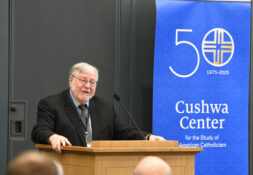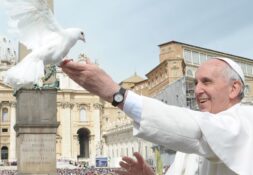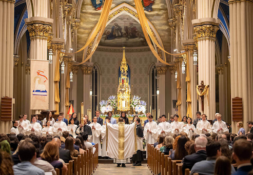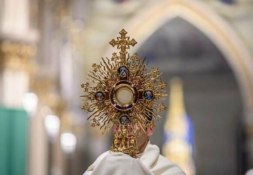On the sacramental home of the consecrated religious
At Notre Dame, and certainly here at CUA in Washington, there are many religious who come from across the country to study philosophy and theology. These religious, most often wearing their habits or religious garb, receive many awkward glances and outright stares, as some utter with surprise: “He/she looks like a Jedi!”
Of course, these Jedi wield only rosaries and breviaries, but these habits that they wear attract the attention of many who wonder why they wear such garb in the first place. Religious do not seek to be masters of the Force, but masters of the spiritual life, their weapons of choice not lightsabers, but the Light of Life.
The ancient-looking garb they wear, the habit, distinguishes them as consecrated religious in a world that is no longer familiar with what a consecrated religious even is. The habit comes from the Latin habitare meaning “to live or dwell”. We derive the word “habitat” from this same root, a synonym for home or the place where we live. To have a good or bad habit of doing something, too, means that you are “at home,” or comfortable, in doing the action. The habit of the religious is thus considered to be the home of the religious, a transient abode that goes with them wherever they go.
Indeed, the habit is the natural home of the consecrated religious. For a religious vowed to poverty, it is often the only clothing that he or she owns upon the profession of final vows. For a fashionista or one who prizes clothes more than he cares to admit, this would seem unfathomable to consign oneself to wear the same thing day after day, year after year. Indeed, it is a consignment, but not in the sense implied here. The donning of the habit is simultaneously a liberation and a consignment; a liberation from the cares of worldly goods and desires, but a consignment in identifying outwardly with a particular community and to a particular way of life, a way of life that catches the world’s attention before it even understands why.
This garb catches our attention precisely because it is so different, so strange in our materialistic world. The habit stands out because it refuses to blend in with the secular world. It is uniquely historical, linking the religious with a present community but also with the ancient predecessors of that community. Yet the habit is distinctly new to us as well, a constant reminder that there are those of us in this world who have publicly dedicated themselves to live poor, live chaste, and live obedient lives to a higher power than themselves. All of this stands in such stark contrast to our increasingly ahistorical and individualistic world, a world that rejects the past and does not embrace self-giving as the basis of communal living, and thus remains a world starved of meaning and love.
As the saying goes, “clothes don’t make the man”, and neither does the habit make the religious. Yet the habit demands from the religious a conformity to a way of life that he agreed upon when he offered himself to serve the Lord through his vows. In putting on the habit every morning, he accepts that the world will look to him as a sign, as a Catholic religious, who is called upon to act as such. The habit is truly sacramental in this sense, for it seeks to manifest externally the grace of a life vowed to God and giving Him alone service and glory. Yes, the habit makes not the religious, just as Baptism makes not the devout Christian, but it serves as a constant reminder to the religious and to the world of the vocation he is called upon to answer every day.
The religious, in donning the habit, stands as a sign in this fallen world of a sense of place, a sense of home, that so many people crave and cannot seem to find. The habit identifies the religious as a religious, consecrated to God and belonging to Him. It identifies the religious as a member of a community, and never as a sole individual divorced from it. It identifies the religious as a person existing in time and gazing out from time, living in the present, in continuity with the past, and hopeful of the future. In a world that seeks these things but cannot find them, the religious is the one to be found by this world, to be seen as this sign, and to point the world towards our true home to be found in the love of God and neighbor.
Is it any wonder, then, that those religious orders that have once again embraced the habit as a mark of religious life are once again growing? Indeed, in Holy Cross itself since the re-adoption of the habit we have seen a growth in vocations for that order, and particularly a resurgence in the brother’s vocation which had been practically non-existent for years. Perhaps it is strong to suggest that this correlation equals causation, but perhaps through this outward manifestation of the religious life, and not merely of the priestly life, Holy Cross has rediscovered something essential to the life of the religious, that being the “home” of every religious, the habit which they wear. Indeed, to increase the permissions of wearing the habit for those in formation and for those finally professed can only help to evangelize and promote vocations to the religious life in Holy Cross, for the habit stands as that signpost pointing and leading to a life consecrated to God and His Church by imitating Christ the Head who lived and died poor, lived and died chastely, and lived and died obediently according to His Father’s will. Such simple garments manifest to us the grace of this happy and holy life, a life not without its demands, but one that can lead us to our ultimate home, our final “habitat” of heaven.
Matthew Gambetta is an alum of the University. He was a former resident Knott Hall. He is currently pursuing other academic endeavors but has left his brother behind to keep some Gambetta-ness at the University.






Leave a Reply